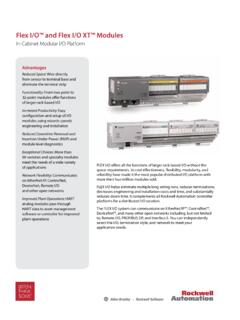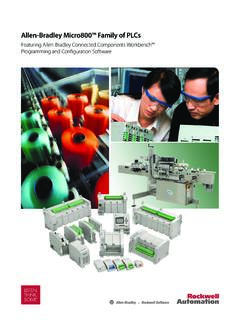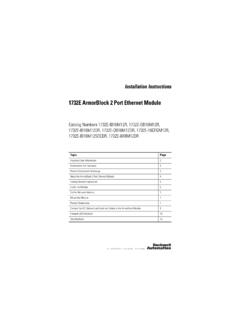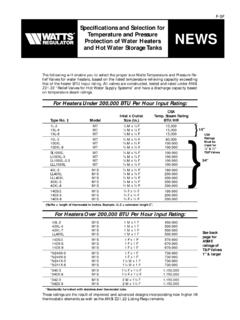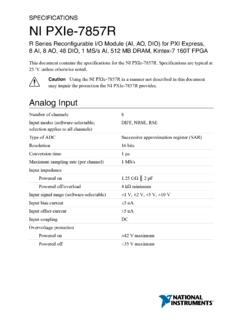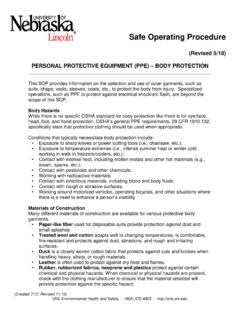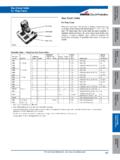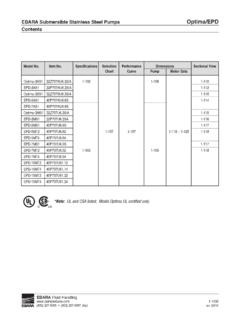Transcription of Specifications - Rockwell Automation
1 1489-M Circuit BreakersRockwell Automation Publication 1492-SG122B-EN-P January 201410 Electrical RatingsPoles1, 2, 3 Tripping characteristicsC, DRated current (In) ARated frequency [f ]50/60 HzRated insulation voltage Uiacc. to IEC/EN 60664-1 Phase-to-ground250V AC Phase-to-phase440V ACOvervoltage categoryIIIP ollution degree3 Data acc. to UL/CSAR atedvoltage AC1-poleC A277V A 240V ACD A277V A240V AC2-, 3-poleC A480Y/277V A 240V ACD A480Y/277V A240V ACDC1-pole48V DC2-pole96V DC (2-pole in series)Rated interrupting capacity acc. to UL 48910 kAReference temperature for tripping characteristics40 CElectrical endurance6,000 operations (AC andDC); 1 cycle (1s - ON, 9s -OFF)Data acc. to IEC/EN 60947-2 Rated operationalvoltage (Ue)1-pole230V AC2-, 3-pole400 V ACHighest supply orutilization voltage(Umax)AC1-pole253/440V AC 2-, 3-pole440V ACDC 1-pole48V DC2-pole96V DCMin. operating voltage12V AC, 12V DCRated ultimate short-circuit breaking capacity Icu15 kARated service short-circuit breaking capacity Ics 40 A: kA>40 A: kARated impulse withstand voltage Uimp.
2 ( s) 4 kV (test voltage atsea level, 5kV at 2,000m)Dielectric test voltage2 kV (50/60Hz, 1 min.)Reference temperature for tripping characteristics30 CElectrical endurance1 cycle (2s - ON, 13s - OFF, In 32A), 1 cycle (2s - ON, 28s - OFF, In > 32A)In < 30A: 20,000operations (AC),In 30A: 10,000 ops.(AC); 1,000 ops. (DC); Self-declared IEC DC DataHousingInsulation group II, RAL 7035 Indicator windowred ON/green OFFP rotection degree acc. to EN 60529IP20, IP40 in enclosure with coverMechanical endurance20,000 operationsShock resistance acc. to IEC/EN 60068-2-2725 g - 2 shocks - 13 msVibration resistance acc. to IEC/EN 60068-2-65g - 20 cycles at Hzwith load InEnvironmental conditions (dampheat) acc. to IEC/EN 60068-2-30 C/RH28 cycles with 55 C/90-96% and25 C/95-100% Ambient temperature +55 CStorage +70 CInstallationTerminalDual terminalCross-section of conductors (top / bottom) solid, stranded 35/35 mm2 Flexiblemm225/25 mm2 AWG18 - 4 AWGC ross-section of busbars (top / bottom)mm210/10 mm2 AWG18 - 8 AWGT ightening torqueN N min lbAWG 18-16: in lb, AWG 14-10 in lb, AWG 8-4: in lbScrewdriverNo.
3 2 PozidriveMountingDIN rail (EN 60715, 35mm) with fast clipMounting positionAnySupplyOptionalApproximate Dimensions and WeightPole dimensions (H x D x W)111 x 69 x mm ( x ")Pole weight125 g ( oz.)Combination with Auxiliary ElementsAuxiliary contactYesSignal contactYesShunt tripYes 35mm self-declared, not included in IEC/EN approval. Refer to the Ambient Temperature Derating Circuit BreakersRockwell Automation Publication 1492-SG122B-EN-P January 201411 Note:Dimensions are shown in millimeters (inches). Dimensions are not intended for manufacturing DimensionsPower Loss Due to CurrentRated Current [A]Power Loss PerPole [W]Rated Current [A]Power Loss PerPole [W] mm( )67 mm ( ) mm( )111 mm( )74 mm ( ) mm( ) mm( )69 mm ( ) mm( )111 mm( )75 mm ( )2-, 3-Pole2-Pole3-Pole1-Pole1489-M Circuit BreakersRockwell Automation Publication 1492-SG122B-EN-P January 201412 Bulletin 1489-M circuit breakers may be used to protectbranch circuits.
4 A branch circuit is the wiring portion of asystem extending beyond the final overcurrent deviceprotecting the circuit. Guidelines established in NEC, CEC, UL,and CSA should be used to determine the specific example:Motor Branch CircuitBulletin 1489-M circuit breakers are not horsepower ratedbecause they are able to safely interrupt currents far inexcess of the locked rotor value for a selected motor. Thisability is recognized in the codes and standards and is alsoestablished by the UL and CSA tests described in UL 489and CSA No. 5 size of a Bulletin 1489-M circuit breaker should bedetermined following the guidelines for an Inverse TimeCircuit : NEC and UL 489. Also see CEC andappropriate Canadian ProtectionBulletin 1489-M circuit breakers may be used fortransformer protection following the : NEC 450 and UL 489. Also see CEC and appropriateCanadian CircuitsApplication InformationCircuit VoltageThe Bulletin 1489-M circuit breakers are rated by voltageclass.
5 Applications should not exceed the listed voltage andcurrent FrequencyThe Bulletin 1489-M circuit breakers may be applied tofrequencies of 50 Hz and 60 Hz without derating. Forapplications above 60 Hz, contact Rockwell Automation withspecific application information for the derating of the Short Circuit CurrentThe Bulletin 1489-M circuit breakers should only be appliedin those applications in which the available short-circuit (orfault) current is less than or equal to 10 kA (US/Canada) and15 kA (IEC).Application ConsiderationsTripping CharacteristicsThe trip curve characteristics are shown on the followingpages. The trip bands shown for each breaker representcurrent tripping limits for a circuit breaker and are within thelimits established by standard tripping characteristic for Bulletin 1489-M isType C. Type C has a magnetic trip activated at 5-10 timesthe rated current of the circuit breaker. The referencetemperature for the thermal tripping characteristics is 30 Type C characteristic will suit most applications.
6 In rare occurrences when the Type C characteristic does notfully meet the application, Type D magnetic tripcharacteristic is available, allowing for transientsapproximately twice as high as the standard Type C. For a specific current at 30 C, a circuit breaker will open("clear the circuit") automatically at some total time that willbe within the minimum and maximum time shown on thecurves. For example, a one-pole, 15 A, Bulletin 1489-M circuitbreaker trips in not less than 1 s and not more than 200 s ona 30 A current. Because the UL standard defines this timespread, users should not specify exact tripping time. Thelower current portion of the curves (upper left) depicts thetime to trip due to thermal action and reflect overloadprotection of the wire and connect load. The higher currentportion of the curves (lower right) depicts the trip due tomagnetic action of the circuit breaker and reflects protectiondue to short circuit level currents.
7 The following is a discussion of application considerationsrelated to North American applications. When applying productto IEC regional requirements, follow IEC practices and selection of a specific ampere rating for a specificapplication is dependent on the type of load and duty cycleand is governed by the National Electric Code (CanadianElectric Code) and UL/CSA. In general, the codes require thatovercurrent protection is at the current supply and at pointswhere wire sizes are reduced. In addition, the codes statethat conductors be protected according to their currentcarrying capacity. There are specific situations that requireapplication consideration, such as motor circuit, andguidelines for the selection for transformer Bulletin 1489-M circuit breakers are non-100% rated asdefined by UL 489, para As such, the circuit breaker'srating should be loaded to no more than 80% if used withcontinuous and load may be reversed.
8 The Bulletin 1489-M circuitbreaker may be bottom Circuit BreakersRockwell Automation Publication 1492-SG122B-EN-P January 201413 HACR RatingBulletin 1489-M Circuit Breakers are rated as Heating, AirConditioning and Refrigeration circuit breakers as defined byUL 489, paragraph and may used in this type RatingThe Bulletin 1489-M breakers ( .. 20 A) are rated as SWD(Switch Duty) and as such may be applied to switchfluorescent lighting loads up to their current and 1489-M Circuit Breakers are rated as current limitingcircuit breakers as defined by UL 489, paragraph Bulletin 1489-M line features the ability to achieve shortcircuit interruptions far more effectively than conventionalbreakers. In conventional circuit breakers, the short circuitinterruption time required is approximately one or two halfcycles of an AC sine wave. When the contacts open, theresulting arc continues to burn until the current level passesthrough zero.
9 The arc may re-ignite because of theinsufficient width of the contact gap. The current that flowsuntil the arc is extinguished produces a heating effectproportional to the I2t value (let-through-energy) of the Bulletin 1489-M device is designed to substantiallyreduce the amount of let-through-current and the resultinglet-through-energy that can damage protected Bulletin 1489-M has the ability to interrupt short circuitcurrent within the first half cycle of the fault. Limiting let-through current and energy will protect against the harmfuleffects of overcurrent and is focused primarily on avoidingexcessive heat and mechanical an orderly shutdown is required to minimize thehazards to personnel and equipment, a system ofcoordination based upon the faulted or overloaded circuit isisolated by selective operation of only the overcurrentprotective device closest to the overcurrent condition. Theuser should select devices that meet this : NEC Also see Overcurrent ProtectionCurrent LimitingHeater Load, Lighting, and Other Load ProtectionBulletin 1489-M circuit breakers may be used for protectionof heater loads, lighting loads, and other loads followingthe guidelines : NEC Article 31 and UL 508A.
10 Also see CEC andappropriate Canadian of these factors are proportional to the square of thecurrent. Thermal energy is proportional to the square of theRMS value and magnetic forces are proportional to thesquare of the peak value. The most effective way to provideprotection is to substantially limit let-through-energy. Thisprovides the following advantages: Far less damage at the location of the short circuit. Fast electric separation of a faulty unit from the system,especially power supplies connected in parallel that areswitched off when the voltage of the power bus dropsbelow a certain level. Far less wear on the miniature circuit breaker itself. Thismeans more safe interruptions. Better protection of all components in the short circuitpath. Far wider range of selective action when used with anupstream protective device. (No nuisance shut downsfrom feeder line interruptions, causing a blackout in allconnected branches.)



